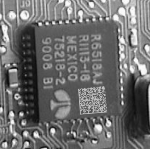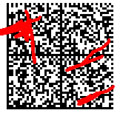DataMatrix Technology |
||||||||||||||||||||||||||||||||||||||||||||||||||||||||||||||||||||||||||||||||||||||||||||||||||||||||||||||||||||||||||||||||||||||||||||||||||||||||||||||||||||||||||
|
Data Matrix, the public domain code from RVSI Acuity CiMatrix, is a 2D matrix symbology designed to pack a lot
of information into a very small space. The Data Matrix symbology employs Reed-Solomon error correction with
data redundancy to guarantee a fast and accurate read. The symbol can store between one and 3116 numeric or
2335 alphanumeric characters. The symbol is also scalable between a 1-mil square to a 14-inch square. That means
that a Data Matrix symbol has a maximum theoretical density of 500 million characters to the inch! The practical
density will, of course, be limited by the resolution of the printing and reading technology used.
Compared to other barcode types, Data Matrix is approximately 30 times smaller than a Code 39 barcode representing the same data.
Because of the required Reed Solomon error correction built in to ECC200 Data Matrix, it is very dependable and can even be read in with a scanner when part of the symbol has been destroyed. With Data Matrix, the worst case chance of a misread is 1 error in 10.5 million scans. In a Code 39 barcode, the worst case chance of a misread is 1 error in 1.7 million*.
Six symbol formats are specified in a rectangular form.
Symbols are intended to be read when marked so that the image is either dark on light or light on dark.
Our DataMatrix ActiveX Control supports all data matrix formats. The following table contains the size, the capacity and the correction error features of each format. By default, the encoding mode is BASE256 (or binary) for compatibility reasons. If you are encoding text or numbers only, you will want to change the encoding mode if size is a concern. Using the appropriate encoding mode, you should be able to achieve the sized specified here.
The DataMatrix ActiveX control supports the encoding modes listed below. By default, the encoding mode is BASE256 for compatibility. If you are encoding text or numbers only, you will want to change the encoding mode, if size is a concern. Using the appropriate encoding mode, you should be able to achieve the sizes specified in the DataMatrix formats table. The data represented in the symbol can be compressed using one or several of the following algorithms:
As a general rule, you should use ASCII to encode text that includes uppercase and lowercase letters with or without numbers and punctuation. All encoding systems can be used to encode any type of data, however, encoding binary data with C40 generates much more overhead (a larger symbol) than with BASE256. |




